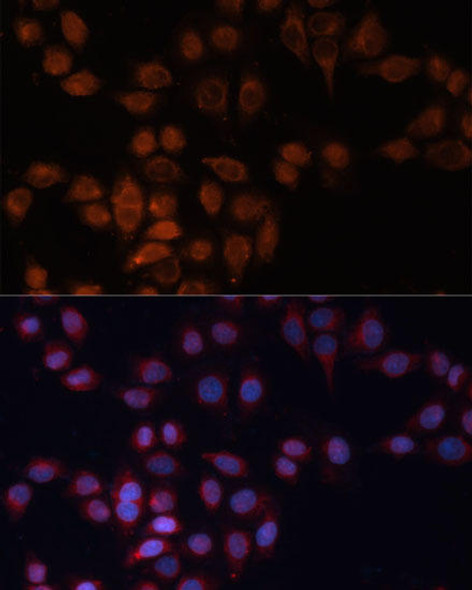Cardiovascular Antibodies
Anti-ADAM15 Antibody (CAB6813)
- SKU:
- CAB6813
- Product Type:
- Antibody
- Reactivity:
- Human
- Reactivity:
- Mouse
- Reactivity:
- Rat
- Host Species:
- Rabbit
- Isotype:
- IgG
- Research Area:
- Cardiovascular
Description
| Antibody Name: | Anti-ADAM15 Antibody |
| Antibody SKU: | CAB6813 |
| Antibody Size: | 20uL, 50uL, 100uL |
| Application: | WB IHC IF |
| Reactivity: | Human, Mouse, Rat |
| Host Species: | Rabbit |
| Immunogen: | A synthesized peptide derived from human ADAM15 |
| Application: | WB IHC IF |
| Recommended Dilution: | WB 1:500 - 1:2000 IHC 1:50 - 1:200 IF 1:50 - 1:200 |
| Reactivity: | Human, Mouse, Rat |
| Positive Samples: | HCT116 |
| Immunogen: | A synthesized peptide derived from human ADAM15 |
| Purification Method: | Affinity purification |
| Storage Buffer: | Store at -20'C. Avoid freeze / thaw cycles. Buffer: PBS with 0.02% sodium azide, 0.05% BSA, 50% glycerol, pH7.3. |
| Isotype: | IgG |
| Sequence: | Email for sequence |
| Gene ID: | 8751 |
| Uniprot: | Q13444 |
| Cellular Location: | |
| Calculated MW: | 90, 100kDa |
| Observed MW: | 100KDa |
| Synonyms: | MDC15 |
| Background: | The protein encoded by this gene is a member of the ADAM (a disintegrin and metalloproteinase) protein family. ADAM family members are type I transmembrane glycoproteins known to be involved in cell adhesion and proteolytic ectodomain processing of cytokines and adhesion molecules. This protein contains multiple functional domains including a zinc-binding metalloprotease domain, a disintegrin-like domain, as well as a EGF-like domain. Through its disintegrin-like domain, this protein specifically interacts with the integrin beta chain, beta 3. It also interacts with Src family protein-tyrosine kinases in a phosphorylation-dependent manner, suggesting that this protein may function in cell-cell adhesion as well as in cellular signaling. Multiple alternatively spliced transcript variants encoding distinct isoforms have been observed. [provided by RefSeq, Jul 2008] |
| UniProt Protein Function: | ADAM15: Active metalloproteinase with gelatinolytic and collagenolytic activity. Plays a role in the wound healing process. Mediates both heterotypic intraepithelial cell/T-cell interactions and homotypic T-cell aggregation. Inhibits beta-1 integrin-mediated cell adhesion and migration of airway smooth muscle cells. Suppresses cell motility on or towards fibronectin possibly by driving alpha-v/beta-1 integrin (ITAGV-ITGB1) cell surface expression via ERK1/2 inactivation. Cleaves E-cadherin in response to growth factor deprivation. Plays a role in glomerular cell migration. Plays a role in pathological neovascularization. May play a role in cartilage remodeling. May be proteolytically processed, during sperm epididymal maturation and the acrosome reaction. May play a role in sperm-egg binding through its disintegrin domain. 11 isoforms of the human protein are produced by alternative splicing. |
| UniProt Protein Details: | Protein type:Membrane protein, integral; Cell adhesion; Motility/polarity/chemotaxis; EC 3.4.24.-; Protease Chromosomal Location of Human Ortholog: 1q21.3 Cellular Component: cell projection; adherens junction; cell surface; acrosome; integral to membrane; plasma membrane Molecular Function:integrin binding; protein binding; zinc ion binding; metallopeptidase activity; metalloendopeptidase activity; SH3 domain binding Biological Process: integrin-mediated signaling pathway; extracellular matrix organization and biogenesis; apoptosis; cell-matrix adhesion; proteolysis; negative regulation of cell-matrix adhesion; collagen catabolic process; extracellular matrix disassembly; tissue regeneration; innate immune response; negative regulation of cell growth; angiogenesis; negative regulation of cell migration |
| NCBI Summary: | The protein encoded by this gene is a member of the ADAM (a disintegrin and metalloproteinase) protein family. ADAM family members are type I transmembrane glycoproteins known to be involved in cell adhesion and proteolytic ectodomain processing of cytokines and adhesion molecules. This protein contains multiple functional domains including a zinc-binding metalloprotease domain, a disintegrin-like domain, as well as a EGF-like domain. Through its disintegrin-like domain, this protein specifically interacts with the integrin beta chain, beta 3. It also interacts with Src family protein-tyrosine kinases in a phosphorylation-dependent manner, suggesting that this protein may function in cell-cell adhesion as well as in cellular signaling. Multiple alternatively spliced transcript variants encoding distinct isoforms have been observed. [provided by RefSeq] |
| UniProt Code: | Q13444 |
| NCBI GenInfo Identifier: | 55960136 |
| NCBI Gene ID: | 8751 |
| NCBI Accession: | |
| UniProt Secondary Accession: | Q13444,Q13493, Q53XQ0, Q5SR68, Q5SR69, Q6R267, Q71S61 Q71S62, Q71S63, Q71S64, Q71S65, B3KQU5, |
| UniProt Related Accession: | Q13444,Q59GF2 |
| Molecular Weight: | 92,959 Da |
| NCBI Full Name: | ADAM metallopeptidase domain 15 |
| NCBI Synonym Full Names: | ADAM metallopeptidase domain 15 |
| NCBI Official Symbol: | ADAM15 |
| NCBI Official Synonym Symbols: | MDC15; ADAM15 |
| NCBI Protein Information: | disintegrin and metalloproteinase domain-containing protein 15; MDC-15; ADAM 15; metargidin; OTTHUMP00000033236; metalloprotease RGD disintegrin protein; a disintegrin and metalloproteinase domain 15 (metargidin); metalloproteinase-like, disintegrin-like, and cysteine-rich protein 15 |
| UniProt Protein Name: | Disintegrin and metalloproteinase domain-containing protein 15 |
| UniProt Synonym Protein Names: | Metalloprotease RGD disintegrin protein; Metalloproteinase-like, disintegrin-like, and cysteine-rich protein 15; MDC-15; Metargidin |
| Protein Family: | Disintegrin and metalloproteinase domain-containing protein |
| UniProt Gene Name: | ADAM15 |
| UniProt Entry Name: | ADA15_HUMAN |







